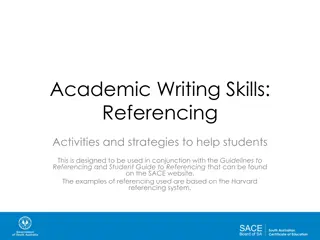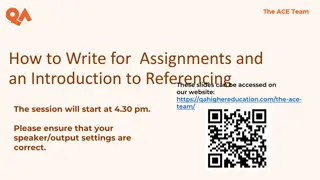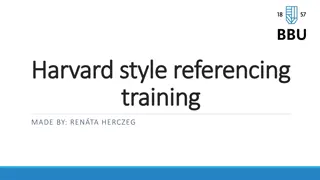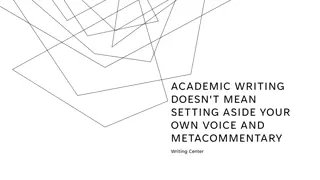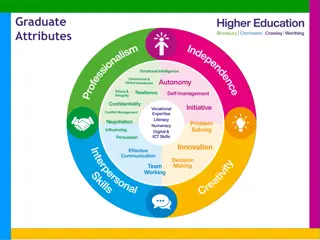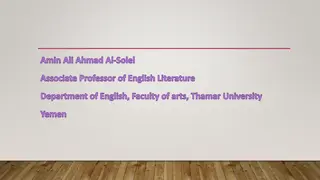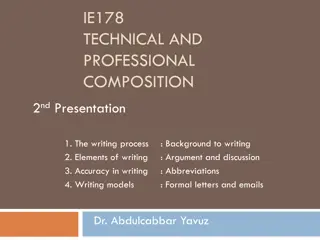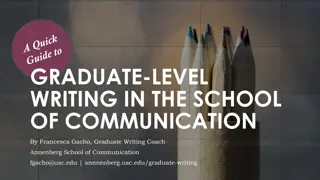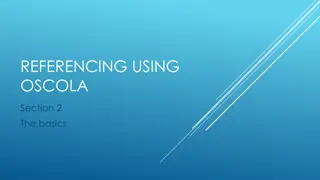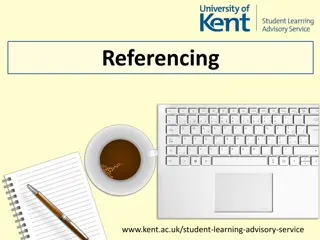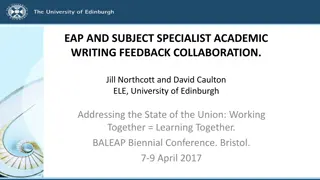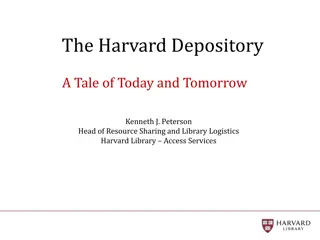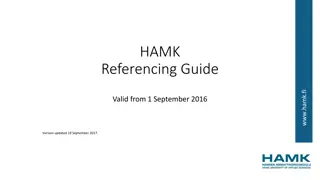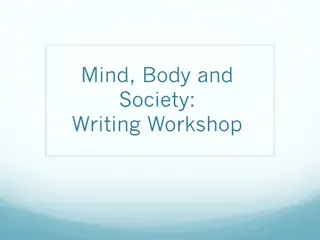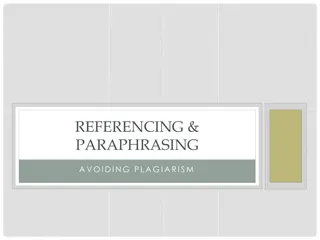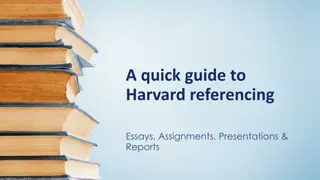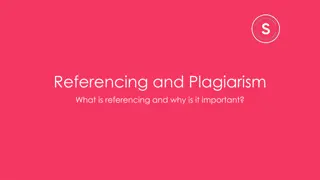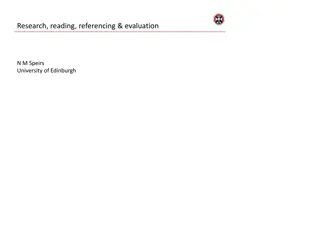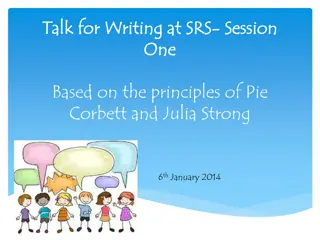Importance of Harvard Referencing in Academic Writing
Essential guidelines for accurately referencing sources in academic writing using the Harvard referencing system. Learn why referencing is crucial, how to cite sources properly, and the significance of maintaining academic integrity through proper referencing practices.
Download Presentation

Please find below an Image/Link to download the presentation.
The content on the website is provided AS IS for your information and personal use only. It may not be sold, licensed, or shared on other websites without obtaining consent from the author.If you encounter any issues during the download, it is possible that the publisher has removed the file from their server.
You are allowed to download the files provided on this website for personal or commercial use, subject to the condition that they are used lawfully. All files are the property of their respective owners.
The content on the website is provided AS IS for your information and personal use only. It may not be sold, licensed, or shared on other websites without obtaining consent from the author.
E N D
Presentation Transcript
Academic Writing Using Harvard referencing
Session Aims: To understand why you need to reference accurately To identify key features of Harvard referencing To introduce the University of Brighton Referencing Guide 2018
Referencing why do we have to do it? The importance of referencing cannot be over-emphasised. It is essential scholarly practice. You are borrowing someone else s ideas and need to recognise the source If you do not reference then you can be accused of plagiarism If you quote the exact words of another writer (Direct Reference) in any essay or paper of your own, then you MUST acknowledge the source of the quotation. (author s surname, date, page) Similarly you MUST acknowledge the source of an example, idea, argument or theory that you are describing in your own words (Indirect Reference)(author s surname, date) At the end of your essay, you must write a list of references in alphabetical order by surname of author
Referencing Look at the sample from a Level 4 assignment. What examples of citing the work / ideas of other people can you find? Highlight and mark the examples
Inclusion is the practice of increasing participation and removing exclusionary pressures (Nutbrown and Jones 2014, p.27). Inclusive learning is not only imperative for children to be fulfilled within their education, but it also quantifies the level of interaction and personal achievement within the classroom. In order to support pupil participation and fulfilment, teachers need to be aware that they are responsible for maintaining an inclusive learning environment and that their constantly evolving values and beliefs have a key role to play. As a teacher develops their pedagogical practice, it is important to realise that: The values that you bring to the classroom, through your personality, enthusiasm, emotions and priorities, combine to influence children and affect their feelings of self-worth and desire to learn (Hayes, 2015, p.172). Triggs (2016) argues that teachers need to be reflective in order to consider their own beliefs and values and the impact they can have on their pupils motivation and outlook. Recent research, (Smith et al, 2017), supports this idea but also points out that time needs to be provided for teachers to reflect and discuss their values and beliefs with colleagues. This would seem to show that
Harvard Referencing Referencing is the acknowledgment of all the sources you have cited in your assignments, whether you have quoted directly or indirectly. The Harvard system uses the author date method; the citations in the assignment text are given in brackets and the list of references is given in a reference list, attached to the assignment. Referencing enables you to: show you have researched your topic, for example: articles, books, reference works and electronic resources direct your readers to the information you have used avoid plagiarism Watch up to 3.14 https://www.youtube.com/watch?v=NDgqqPvMn0U
University of Brighton Referencing Guidance 2018 Please use and follow the University Referencing Guidance Handout provided in session). This explains the how and why of referencing and shows how to present some of the most common types of source in your reference list Link to Referencing Guide 2018 (click on Referencing Getting it Right) This is based upon : Pears, R. and Shields, G. (2016) Cite them right: the essential referencing guide. 10th edn. London: Palgrave. (copies in library) Please use this book to support you with how to present all types of sources in your reference list.
Short Direct Quote ( less than one line taken word for word from original text) This finding corroborates the ideas of Anderson and Kennedy , who suggested that In successful groups, all students equally contributed towards the final product (2014, p.35). Or Setting ground rules and expectations can help to facilitate a shared sense of responsibility. Although people will sometimes have different viewpoints it is how that conflict is handled which determines whether it works to the team's advantage, or contributes to its demise (Chasteauneuf, 2014, p.19). What are the presentation requirements here? NB: 1.5 or double spacing for main body of text Note the use of : quotation marks name, date , page
Long Direct Quote (longer taken word for word from original text) taken word for word from original text) (longer than one line than one line The benefits of learners working in group situations and the importance of group goals and individual accountability is clearly recognised. However, it is more complex: Within-class grouping also makes little difference, because what really matters is not how students are grouped. It is what happens in the groups, and that depends crucially on the quality of the teacher (Totraku, 2014, p.201). What are the presentation requirements here? NB: 1.5 or double spacing for main body of text Note : no quotation marks indentation for the quoted text name , date, page after quote
Or Direct quote - long The benefits of learners working in group situations and the importance of group goals and individual accountability is clearly recognised. However Totraku, suggests it is more complex: Within-class grouping also makes little difference, because what really matters I not how students are grouped. It is what happens in the groups, and that depends crucially on the quality of the teacher (2014, p.201). NB: 1.5 or double spacing for main body of text Note the use of : smaller font size no quotation marks single line spacing indentation for the quoted text name used in introduction of quote so not needed with date and page at end
Indirect Quote When you use and author s ideas but put them in to your own words (paraphrase or summarise) Professionalism is a key aspect of being a teacher. (Totraku, 2014). Or Totraku s (2014) study set out with the aim of highlighting the importance of professionalism for teachers. What are the presentation requirements here? NB: 1.5 or double spacing for main body of text Note the use of : name and date only PLEASE NOTE . THIS DIFFERS SLIGHTLY FROM CITE THEM RIGHT PAGES 10-11 BUT SIMPLIFIES THE PROCESS OF PRESENTING INDIRECT QUOTES TO JUST NAME AND DATE (NEVER THE PAGE)
Creative exploration is a key approach to science teaching and learning . It mirrors many aspects of the ways in which scientists work. It requires both the teacher and children to make the science and scientific processes involved explicit. It is about children s science : children personalising their science activity leading to their development of creative explanations of natural phenomena. It requires children to be involved in exploration, enquiry, explanation and making connections and is often ignited by aesthetic experiences that promote affective and sometimes emotional responses. It is associated with dispositions such as fascination, anticipation, engagement, awe, wonder, interest and curiosity and can lead to the use of scientific enquiry to develop explanations of natural phenomena. Creative exploration is a sequential or cyclic model of exploring for understanding in children s science. It is based on the assumption that children naturally seek explanations for experiences that have some effect on their feelings, attitudes and the manner in which they think about or view natural phenomena. Children will often construct creative explanations when seeking to understand and explain the phenomena involved in their aesthetic experiences. The outcome of such creative explanations is a greater depth of understanding, especially if the learner involved has communicated and justified their ideas with others. Cite as a short direct quote Cite as a long direct quote Cite as an indirect quote From page 61 in Teaching Science Creatively by Dan Davies published in 2011 by Routledqe in Abingdon.
The answer: Short Direct quote Creative exploration is a key approach to science teaching and learning (Davies, 2011, p.61). or Davies (2011) believes that creative exploration is a key approach to science teaching and learning (p.61). or Davies believes that creative exploration is a key approach to science teaching and learning (2011, p.61).
The answer: Long direct quote It could be argued that: It requires children to be involved in exploration, enquiry, explanation and making connections and is often ignited by aesthetic experiences that promote affective and sometimes emotional responses. (Davies, 2011,p.61) or Davies argues that : It requires children to be involved in exploration, enquiry, explanation and making connections and is often ignited by aesthetic experiences that promote affective and sometimes emotional responses. (2011,p.61)
The answer: Indirect quote It has been pointed out that children construct and deepen their own explanations and ideas and this can be supported by talking with others (Davies, 2011) Or Davies (2011) believes that children construct and deepen their own explanations and ideas and this can be supported by talking with others
Direct or Indirect which should you use? Direct Quotes: Taken directly from text word for word Can prevent you from showing your understanding? Can disrupt flow of the text? Can use up significant part of your word allowance? Indirect Quotes: Other author s ideas paraphrased or summarised in to your own words Can help you demonstrate greater understanding? Shows your interpretation of the evidence? Can support flow of the text? Key Points- whether direct or indirect, make sure quotations are relevant to your arguments and correctly presented
List of References You need to include a list of references (not a bibliography) at the end of your assignment Just include the sources you included in your text List all references in alphabetical order according to authors names Don t separate out books, journals, web sites etc. Follow the Guidelines for Referencing (Based on Cite Them Right). These show how some sources should be presented in the reference list For a definitive guide for all sources, please use Pears, R. and G. Shields. 2016. Cite them right: the essential referencing guide. 10th edn. London: Palgrave.
Example Reference List (not real sources!) Baines-Holmes, J. (2018) Students Love Referencing', The Times, 24 Jul7, p. 2. Bradford, M. and Briggs, J. (2010) Being a Specialist: the essential guide for students. London: Sage. Brooker, J. (2008) Science do we need it?. Unpublished PhD thesis. Brighton University. Triggs Foundation (2018) KTF. Available at: https://www.kbt.org.uk/ (Accessed: 26 July 2018). Harvey-Swanston, R. (2013) A qualitative investigation into how problem-based learning impacts on the development of team-working skills in teacher trainees , Journal of Further and Higher Education, 39(1), pp. 6 20. Herbert, P. (2010) Being a First Year Student. Aldershot: Gower. Prajapat, B. (2016) DT at University. Available at: http://uni.com/2016/06/07/DT is the best / (Accessed: 26 July 2018). Smith, J. (2012) 'Managing Workload', in Goodman, R. (ed.) Workload and how to love it. Lancaster: MTX, pp. 8 12. .
Spot the errors and correct this reference list for the book, web page and journal article Bob Jones 2012 Education, Education , Education (3rd Edition), OU Press : Birmingham Online :Smith, Tom. [2017] Education For All http://www.skillsnot.ac.uk {11 October 2017} Science is Great , by Triggs, Keith. (2013) Primary Science Review, 45, pages 18-24 The answers Jones, B. (2012) Education, Education , Education (3rd Edition), Birmingham: OU Press. Smith, T. (2017) Education For All. Available at: http://www.skillsnot.ac.uk/ (Accessed: 11 October 2017). Triggs, K. (2013) Science is Great , Primary Science Review, 45, pp. 18-24.
Reminder re 500 word writing task By Monday 5th November you will need to upload to Turnitin the 500 word piece of academic writing introduced by Keith and Richard I will allocate time slots in the weeks commencing 12th, 19th, 26th Nov and 3rd Dec for you to meet with me one to one to go through your piece of writing and provide verbal feedback Follow up Task: In response to this feedback you will reflect on your writing and prepare an academic action plan, together with the steps you need to take to improve in this area.
Success criteria It will posses an academic tone It will make sense, be accurately punctuated and spelt correctly Your ideas and points will be supported by drawing on and making reference to your reading and personal experience. It will demonstrate your ability to use the Harvard reference system It will be critical rather than overly descriptive
Non Contact: Read and get familiar with Guidelines for the Use of References. Get familiar with a copy of Cite Them Right Write and submit your 500 Words!


